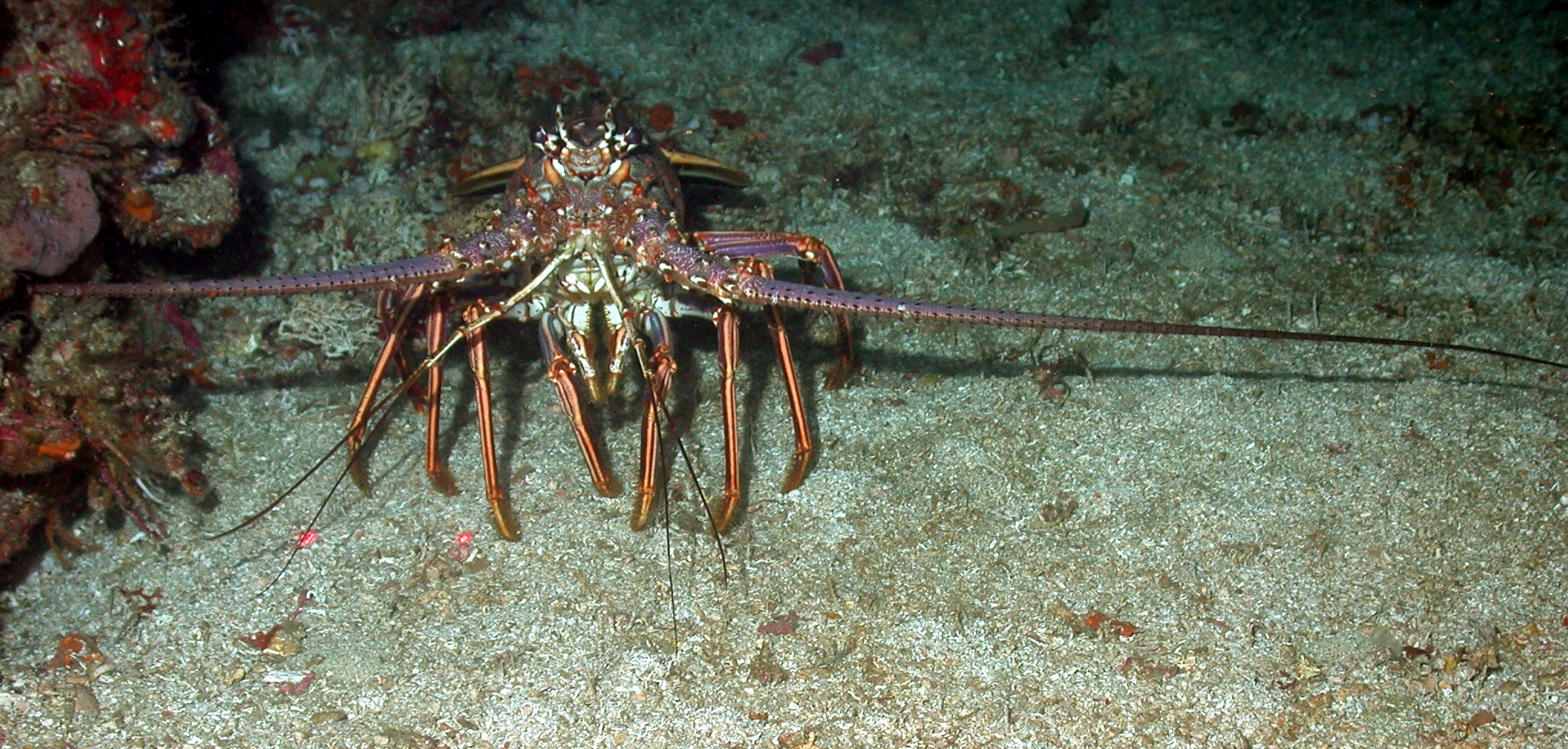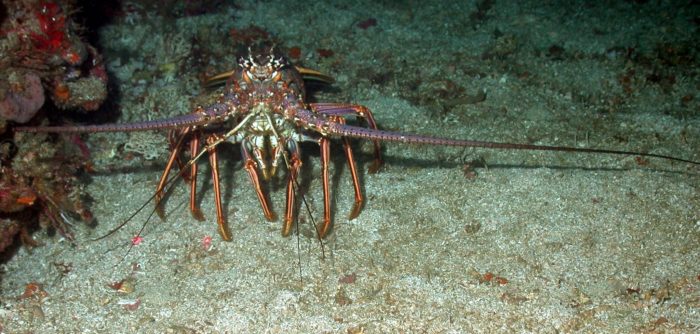
Creature Feature: Spiny Lobster

Photo Credit: Andrew David, NOAA/NMFS/SEFSC Panama City; Lance Horn, UNCW/NURC – Phantom II ROV operator.
When you think of lobsters, you probably think of a long crustacean with large claws, antennae, and fanned, muscular tails — you may also think of dinner. However, there are lobsters of all shapes, sizes, and looks that call the ocean home. One unique species is the Caribbean spiny lobster (Panulirus argus), also known as crawfish, which are found in the Caribbean Sea, Gulf of Mexico, and the Atlantic Ocean, including Florida Keys National Marine Sanctuary.
Appearance
Spiny lobsters are crustaceans just like crabs, shrimp, and even krill. They can be identified by their hard, bumpy exoskeleton and appear in a range of colors from nearly-white to dark red-orange. As with most arthropods, spiny lobsters molt — shed their hard exoskeleton — as they grow, which leaves them more vulnerable to predators. They have two long antennae that they use for defense, two smaller antennules they use for sensory perception, and do not have claws as you would find on Maine lobsters. Fully grown adult spiny lobsters can reach about two feet (60 cm) in length and can weigh up to 15 pounds.
Habitat
Spiny lobsters live in tropical and subtropical reefs, which are full of hiding spots for these nocturnal animals, seagrass meadows and algal beds, and in rocky, nearshore areas. As an added bonus, spiny lobster coloration and texture helps them blend into the reef, making it less likely that predators or prey will be able to see them clearly.
Diet & Life History
Spiny lobsters are nocturnal animals (meaning they are most active at night) and opportunistic feeders, meaning they will eat whatever they can find. Generally, larvae feed on plankton while juveniles and adults feed on snails, crabs, clams, worms, and even the remains of decaying animals on the ocean floor. Spiny lobsters are prey for eels, fish, crabs, humans, and even other lobsters, and larvae/juveniles that live nearshore can even be a tasty snack for seabirds.
These lobsters reproduce in the spring and summer months, with a single female laying over one million eggs during the reproductive period. Female lobsters carry orange eggs on their undersides, releasing them when they are ready to hatch. Ocean currents are much stronger than spiny lobster larvae, and they can be carried thousands of miles from their original habitat. Larvae settle inshore and move to offshore reefs as they grow. It can take an individual lobster more than two years to reach their full adult size and they can live up to 15 years, though this isn’t the average lifespan.
Threats and Conservation
As with many other animals in the Florida Keys, spiny lobsters are vulnerable to degradation of coral reefs, underwater marine debris, climate change, and ocean acidification, which can weaken the shells of their prey.
Spiny lobsters have meaty tails and are one of the larger species of lobster found in the United States, making them attractive to commercial and recreational fishers alike. In fact, according to the Florida Fish and Wildlife Commission, the spiny lobster fishery is the largest commercial fishery in the state of Florida when measured in dollars. According to Florida Keys National Marine Sanctuary, commercial lobstering alone contributes more than $5 million to the local economy every year, not to mention the value added by recreational fishers who travel to the Keys to try their hand at lobstering.
Gone unchecked, spiny lobster fishing could put local populations at risk. Luckily, the state of Florida and federal fisheries councils limit the number of lobsters each individual or company can take through a permitting process and have established a minimum size requirement so juveniles have the opportunity to reach adulthood and reproduce. Fishers and divers must return any females carrying eggs that they find. Lobster mini-season usually occurs annually on the last Thursday and Friday in July, with the full, regular season lasting from August to March.
